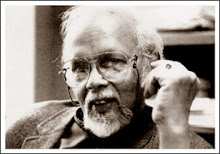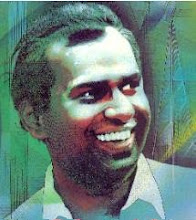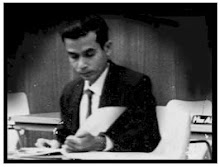Source: Sunday Observer
Date: 29/08/2007
 Prof. Ediriweera Sarachchandra’s Sinha Bahu highly influenced by Kooththu and Nadagam tradition of drama.
Prof. Ediriweera Sarachchandra’s Sinha Bahu highly influenced by Kooththu and Nadagam tradition of drama. When the travelling troupe of Sri Lankan theatre personality visited University of Madras and other higher educational Institutions in Tamil Nadu, the documentary on Kooththu, a traditional Sri Lankan Tamil Dance Drama was showed as one of the prized item in the cultural baggage that the Sri Lankan delegates brought to India.
Perhaps, this had been a rare occasion that people of Tamil Nadu and its intelligencia, were able to get an insight into traditional dance forms in the North and East of Sri Lanka.
Kooththu is one of the rare traditional Tamil Dance Drama which has been preserving its original characteristics although several sub-divisions sprang from it.
Kooththu is a traditional village dance form which constitutes the very core of the Tamil folk theatre. Kooththu, literary mean leap, and the principle mode of expression is dance.
 Trikone Chief Dharmasiri Bandaranayake addressing a gathering in Tamil Nadu during Tri Nethra cultural programme |
 A section of the enthusiastic audience consists of scholars and academics during an interaction. |
 |
When an actor is portraying characters in Kooththu, it is commonly termed as Kooththu Adinaan. Although Kooththu is classified as a traditional village dance form, modern characteristics of dancing traditions such as Bhratha Natyam, can be integrated into this unique form of traditional drama. For instance, in the epic Silapathikaram, Kooththu has been classised. In the epic, Madhawi, a character, performs eleven types of Kooththu.
According to Prof. K. Sivathamby, former head of Department of Tamil University of Jaffna, even the dance of lord Siva is also considered as Kooththu. For this reason lord Silva is also known as Kooththan, the dancer.
Although Kooththu had been popular among all segments of the population, it was delegated to the low castes in the caste hierarchy with the advent of Brahmins and the subsequent establishment of caste hierarchy. Under the modern influence, the position Kooththu held in Tamil theatre was further lowered to its present status.
One of the significant developments that took place under the English influence in the Kooththu tradition was the inclusion of spoken words in the performance.
Traditionally Kooththu performances were held at Temples and streets. It is staged in a circle called Kalari, the same word is used in Kandyan dance and Malayalam dances.
People sit around the Kalari to watch the drama, however, it is not clear whether they have understood the narration of the drama. People consider Kooththu as a ritual which has been passed down from generation to generation.
Dancing is a primary step towards Kooththu or Nadagam. Different characters in the performance use diverse styles and performers move from one place to another.
Performer moves in a circle and when circle is completed even though there is no significant change on the stage, the next movement is considered as a new scene. When there is a fight, the performers move parallel to one another.
Basically there are two styles in Kooththu; Vadamodi and Thenmodi. There are merely two styles, Vadamodi, the Northern style and Tenmodi, the Southern style. Vadamodi style is popular in Batticaloa while Thenmodi is popular in Vaddukodai.
There is a school of thinking that Vadamodi style is used to narrate Mahabharata and Thenmodi for presenting local stories. Mannar is the best place where one can see the modern rendering of Kooththu by the Christian community to narrate religious stories.
The Christians perform Kooththu to narrate all traditional Christian tales. It even flourished in Jaffna.
It is this Christian Kooththu that would have appealed to the Sinhalese in the South and the word 'Nadagam'. The Nadagam is heavily influenced by Christian Kooththu. The tradition travelled from Mannar to Puttalam and then to the coastal town of Negombo.
It could have been moved from Batticaloa to Sabaragamuwa region as there are significant similarities between what Tamil people practiced as Paramelam and Sabaragamuwa dancing. However, this evolution from Batticaloa to Sabaragamuwa has, so far, not been explored.
In 1956, Sinhala renaissance saw the production of Maname by prof. Sarachchandra. Prof. Sarachchandra has mentioned that he drew inspiration from Nadagam and Kooththu. Kooththu tradition is reinvented in Sri Lanka more than in Tamil Nadu where exists a dance form called Therukooththu which is found in Northern part of the state.
Further down Thirivanveli, in addition to Therukooththu, there is Kanniyankooththu. In post-independence India, when people wanted to get rid of Western influence such as dialogue and Proscenium theatre, they turned to traditional theatre forms. They learnt that it was Kooththu which enriched the Tamil theatre in general.
Examining the fundamentals of Kooththu, one could realize the similarities in Sinhalese and Tamil art forms and these similarities are manifested in many art forms such as Kohobakankariya, Nadagam and Sokari. In order to create unity among Sinhalese and Tamil communities, one should look into these similarities in diverse art forms.
Prof. Sivathamby pointed out that such cross cultural studies by the Art Council in 1965 once completed had been neglected by 1980s and that the time is ripe for Sri Lankans to revisit that point in order to look into the common heritage.
The central theme of the programme was to dispel misunderstanding between the two communities as Thrinetra stirred a healthy debate on cross cultural links and fundamental similarities in respective cultures and art forms.
Significant aspect of the programme was that the travelling troupe conveyed the message to the people of Tamil Nadu through the presentation and documentary, shows that the Sinhalese have great cultural heritage which has been the subject of discussion among the academics and scholars.
This is very important at this crucial stage as it will prevent hatemongers from spreading disinformation campaigns, especially against Sinhalese.
The programme was presented by Trikon Arts Centre.




































No comments:
Post a Comment